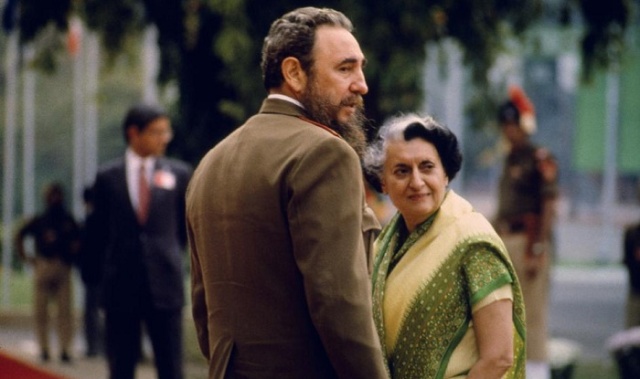
Fidel Castro and Indira Gandhi. Image Source: India.com

Fidel Castro and Indira Gandhi. Image Source: India.com
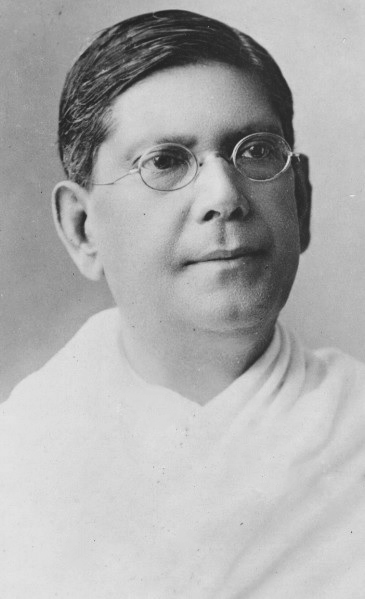
Portrait of Deshbondhu. Image Source: Wikimedia Commons
Like Burke, and the liberals I mentioned in the Ancient Constitution post, Deshbondhu believed that rule of law had to be subservient to some other concept of law (shall we call it natural law?) in order to justify obedience:
Why are the Indian Criminal Law Amendment Act 1908 and the Prevention of Seditious Meetings Act 1911 to be retained on the Statute Book? For the preservation of law and order? They little think these learned gentlemen responsible for the report that these Statutes, giving as they do to the Executive wide, arbitrary and discretionary powers of constraint, constitute a state of things wherein it is the duty of every individual to resist and to defy the tyranny of such lawless laws. These Statutes in themselves constitute a breach of law and order, for, law and order is the result of the rule of law; and where you deny the existence of the rule of law, you cannot turn round and say it is your duty as law-abiding citizens to obey the law.
p. 14

Image Source: Quartz India
This recent spate of “right wing” victories which includes Brexit, Trump, and the European nationalists is part of the same global phenomenon which produced Modi.
It almost seems too obvious to point out how similar Trump and Modi are but I haven’t seen many people in my circles saying it. Probably because I hang out mostly with Americanized NRI liberals in the Brahmin class (as per Moldbug’s schema, not Chaturvarna). These people love Modi and hate Trump and want to avoid finding the obvious similarities and connections. There are some articles tracing out the connections. Mostly in condemnatory tones. But some sources are saying the exact opposite as well, which is totally ridiculous. So lets go over some of the basics.
Victory of the Edgelords: The first major similarity is their negative public branding, and the material causes for why that sort of branding was possible in the first place. Trump and Modi both are both considered bigots by their liberal opponents (particularly in English language media which has been totally captured by leftist establishment forces), and have garnered support from right wing radicals. In Trump’s case this mostly centers around his rhetoric, though he is also favored by far right groups like (numerically and politically insignificant) KKK or the (much more numerous and significant) Alt-Right. In Modi’s case it derives from his institutional connection with the RSS and Hindutvadis in general, and his role in the Gujarat riots. In both cases this seemed to have damaged their reputations and election chances at the time. They were considered outsiders with hickish attitudes by their own liberal countrymen, and scary nationalists by neoliberals in other countries. Remember how under Obama the US denied Modi’s visa? Well Trump narrowly escaped the same fate at the hands of the UK parliament. Ultimately in both cases this politically correct negative branding failed to stop the candidate, as what the media establishment portrayed as a negative and bigoted campaign was interpreted very differently by the voting public.
Did India have an Ancient Constitution worth respecting, or not? Did the British uphold it, or destroy it? For a Libertarian or Burkean Conservative Hindu, these are important questions to consider dispassionately. The answer actually matters. If India had an Ancient Constitution which was destroyed when the British came, then much of India’s existing constitution, a combination of British laws and the arbitrarily imposed theories of Ambedkar, is an usurpation of the ancient rights and privileges primordial to the land and the race. The very basis of the Indian state is in question in this case. On the other hand, if India had no such Ancient Constitution, or if it was destroyed by the Mughals and restored by the British, then the period of British rule was a period of liberation from Oriental Despotism wherein India was Brought Into History as Hegel might have said. This is a somewhat false binary, but I present it anyway to show some of the dramatic potential conclusions we can come to.
Its also important to consider what such a concept as an Ancient Constitution really even means. Is it a principle of abstract justice which is universal? Or do different societies create internally valid social compacts which might differ from one another in legitimate ways? Or is this an incorrect way of framing the question?
I’m not really going to try to definitively settle the historical question in this post. I’m still doing research on the topic and will put out my full view on it later if I think I gain enough information to make such a judgement. I’ll instead just briefly discuss what the idea of an Ancient Constitution meant to a few thinkers in the context of India. I’ll look at Bose, Burke, Roy, and Naoroji.

Portrait of Subhash Chandra Bose. Image source: quotesgram.com
Bose:
(Click to go back to Part I: Doctrines)
(Click to go back to Part II: Proto-Materialism in Vedic and Tantric Traditions)
(Click to go back to Part III: Orthodox Darshanas)
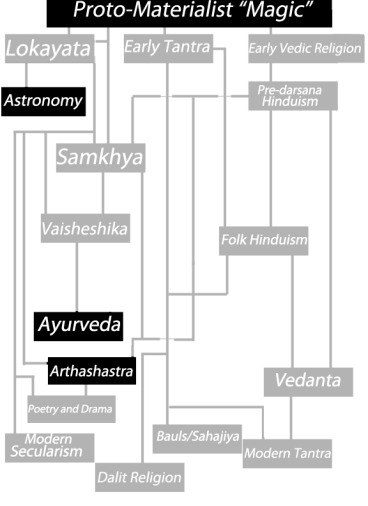
Political theory
The word Lokayata occurs only once in the Arthashastra (PDF here), but it is a very significant mention. The treatise opens with the line “Om, salutations to Sukra and Brihaspati” the two progenitors of materialism and deha-vada (doctrine of the body as soul) in Vedic mythology. There are also numerous mentions of the “school of Brihaspati” later on in the text; though it is ambiguous which school Kautilya is referring to. Kautilya’s mention of Lokayata is as follows:
“Anvikshaki comprises the Philosophy of Sankhya, Yoga, and Lokayata… Righteous and unrighteous acts (Dharmadharmau) are learnt from the triple Vedas; wealth and non-wealth from Varta; the expedient and the inexpedient (Nayanayau), as well as potency and impotency (Balabale) from the science of government.
When seen in the light of these sciences, the science of Anvikshaki is most beneficial to the world, keeps the mind steady and firm in weal and woe alike, and bestows excellence of foresight, speech and action.” (1)
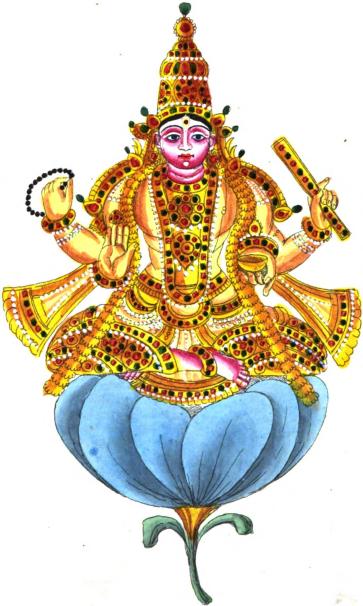
Shukra. One of the teachers of the Asura in Vedic mythology, along with Brihaspati. Source: Wikimedia Commons
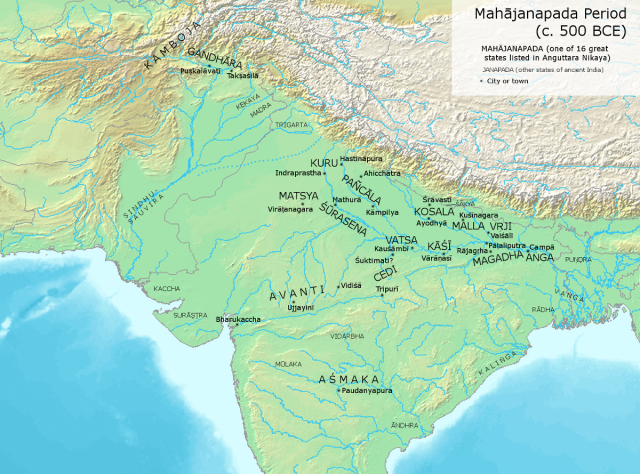
Map of the 16 Janapadas. Source: Wikimedia Commons
I was reading about non-monarchical forms of government in ancient India. Really I was interested in what they call the “Republics” of ancient India. But that concept is a bit misleading. It has all sorts of Eurocentric connotations, and implicit associations with democracy, egalitarianism, populism, etc. It has those implicit connections even though many European republics were essentially similar to the Indian ones insofar as they had restricted franchise and were basically aristocratic or oligarchic in nature, or merchant guild-based. In Sanskrit they were called Janapadas, Gana Sanghas, or a few other more esoteric words.
I suppose one major difference between Indian and European republics is that there is European republics frequently had agents which were said to “represent” the people, implying that “the people” were the sovereign ruler of the society. “The People” generally had an aristocratic definition, but also had the capacity to get quite plebian. It is difficult to tell who was regarded as sovereign in some of the following Indian examples, but if I had to guess I would say that as a general rule the ruling Kshatriya clan, or confederation of clans, was regarded as sovereigs. That said, in other literature I also saw evidence to suggest that sovereignty was also sometimes vested in individual villages, districts, or constituent guilds or corporations which themselves sent representatives to the council. Without copies of their constitutions we don’t know for sure, but I don’t evidence of directly democratic institutions. And why would we? Political egalitarianism is an alien concept to the subcontinent.
Given the existence of these republics really amazing that we still think of India as a static land of “Oriental Despotism.” For instance, we think of Buddha as a “Prince” when really he was a prince only insofar as he was the son of the elected leader of the Shakya Republic (to be fair, Buddhist literature inflates Sudhodana’s reputation which confuses this issue as much as the Hegelian/Marxist historiography). Republics are also central to the history of Jainism. Anyway the point is, India had ancient aristocratic republics and that is cool.
Below is a large chunk of Chapter 1: Forms and Types of States from the book Aspects of the ancient Indian polity, by Narendra Nath Law, (Oxford, The Clarendon press, 1921.) Apologies for the typographical errors, I tried to clean up the ones which inhibited meaning:
I was reading Hegel a while back and I thought my dear readers might want to see some of his content. At the end of this introductory bit I have just excerpted in total “Section II: India” and “Section II: (Continued) India Buddhism” from “Part 1: The Oriental World” of G.W.F Hegel’s The Philosophy of History. So if you’d like to skip my blather, go down to the section “On India” right below the winged Zoroastrian symbol.
Introduction and preliminary analysis:
Everyone seems to dislike that Hegel is overly obtuse and abstract, but when he discusses history he is actually taking in very concrete terms most of the time. This is not exactly a reliable source for specific information about Indian history or philosophy. In some ways it is a better study of how Europeans see India than it is a study of India. It suffers from a caricatured view of India as a land of contradiction, chaos, and conflict. For the most part his characterizations of India aren’t totally baseless though, as stereotypes often have a basis in reality. They are just stereotypical exaggerations or generalizations which lack any sort of nuance or qualification. He also seems to uncritically accept very early orientalist insights in Sanskritic culture as fact, and as reflective of the Indian society of the 1800s. To some degree this is excusable because Sanskrit translations and real detailed historical knowledge of India were still undergoing development in Europe. He had to have been over reliant on early translations of the Vedas, the Dharmashastras (particularly Manu), the Pali canon perhaps, and the writings of some few high-philosophers. Given his time period, his knowledge of Indian philosophy is actually impressive. He writes some rather detailed information here about the Samkhya, Nyaya, and Vaisheshika schools, so he at least knew that much. Yet perhaps I am being too generous to Hegel here. It is somewhat baffling to me how he derives an extreme idealist worldview from these three schools, Vaisheshika in particular. It was reading those philosophical schools which persuaded me that India has a sublimated tradition of naturalism. I feel that if he was also familiar with them it should have occurred to him that Hindu idealism is at least alloyed with a rationalistic form of naturalism.
“In childhood a female must be subject to her father, in youth to her husband, when her lord is dead to her sons; a woman must never be independent….If a wife obeys her husband, she will for that (reason alone) be exalted in heaven.” –Manu Smriti[1] ***
“I have nothing to do with the husbands of this world”- Akka Mahadevi
Akka Mahadevi in samadhi, nude but draped in her flowing hair. Image source.
I’ll try to reserve most of my comments for the end of this post. The following is a collection of verses by female, often low caste Bhakti (devotional) poets which I’ve collected from various books and journal articles. They challenge the way we normally think about women in Hinduism. Caste rules to gender norms, and even the Vedas and Brahmins all are opened up for fiery criticism. This is a part of the Hindu tradition, which often doesn’t get much press. You normally read about how caste is inherent to Hinduism, and how if one Brahminical texts says it, then it is the official, textually certified Hindu position on the matter. Not so. Hinduism is a much more anarchic tradition than that.
The Role of Women:
By Akka Mahadevi (12th century AD):
“The preceptor became the giver;
The Lord Linga became the bridegroom;
And I became the bride.
All this the world knows
The innumerable devotees are my parents
Hence Chenna Mallikarjuna is my husband,O Prabhu,
I have nothing to do with the husbands of this world” [2]
This is an inversion of Manu’s claim that a woman should treat the husband as God. She treats God as her husband.
“On a frame of water, raising a roof of fire,
Spreading the hailstones for the bridal floor-bed,
A husband without a head, married a wife without legs,
My parents gave me to an inseparable life,
They married me to Lord Chenna Mallikarjuna” [3]
Verses such as these can be read as conservative, but remember that this poet, like many others Bhakti sants, did refuse to get married to any man. This wasn’t just talk. Given the stigma attached to unmarried women in Indian society, this was a radical statement. In Akka Mahadevi’s case, she rejected a Jain king named Kausika rendering it an even more powerful act of defiance.
“We must at present do our best to form a class who may be interpreters between us and the millions whom we govern, –a class of persons Indian in blood and colour, but English in tastes, in opinions, in morals and in intellect.” -Lord Thomas Babington Macaulay
“Sexual pleasure is not pleasure. Sex-pleasure is the most devitalizing and de-moralizing of pleasures. Sexual pleasure is not pleasure at all. It is mental delusion. It is false, utterly worthless, and extremely harmful.” -Swami Sivananda Saraswati
An old painting of Kali in Kalighat painting style. This is a blend of traditional Bengali folk styles, and European painting. An in-between version of this scene, not as sexualized as ancient depictions, but not as tame as modern ones either. Image Source.
Westernized or Anglicized Hinduism describes the religious system which is adhered to by most Hindus living in the United States and Britain, as well as by those in the modern Hindu urban elite, middle class, and urban working class. Essentially, any Hindu population which has experienced the impact of a modern education system for a few generations now subscribes to a Westernized variant of the belief system.
Initially I was planning on titling this piece “The Anglicization of Hinduism,” as that is what the bulk of this article pertains to, but that would entail a slight misnomer. This is because aside from morphing under British pressure, the most ancient substratum belief of the Hindu philosophical tree– namely Tantra– has been under a far longer lasting, but less severe morphing due to the influence of Vedic Brahminical tradition which arose in the Western part of the Indian subcontinent. Then, in the British period orthodox Vedic Brahmins eagerly collaborated with the colonial regime. Using it as their vehicle, both the Brahminical and Victorian worldviews, began to permeate the Hindu cultural landscape in unison.
Thus, Hinduism has been “westernized” in two senses: Recent, and rapid influence from Britain, and ancient, gradual influence from Western India. Anglicization and Sanskritization.
Basic Characteristics of Westernized Hinduism in Hindu terms: Modern, Westernized Hinduism is essentially a modified form of Advaita Vedanta, though ISKON (a dualist sect), the Brahmo Samaj, Arya Samaj, Gandhian Hinduism, and indeed nearly every major Hindu religious movement since 1800 can be characterized as Westernized Hinduism, Anglicized Hinduism, or Neo-Hinduism. It is normally highly monistic, and places an emphasis on Bhakti and/or Karma Yoga. Tantra, especially left-hand path Tantra is conspicuously absent. Most Neo-Hindus see Hinduism both as a specific religion, and also as a meta-religious framework, which encompasses all religions. The most popular text in this branch of Hinduism is the Bhagavad Gita. More on all of this later.
Formation of Westernized Hinduism: That covers the Hindu lineage, but there is of course a Western lineage as well. it is also the product of a violent and rapid change in the Indian social order– namely the advent of British colonialism, and eventually modern capitalism. The British Raj accorded a privileged role to Christian values and Western concepts. Starting in about 1858, when the British East India Company was forced to transfer power to the British monarchy, the British began to more actively inject their civilizational model into the subcontinent. The imposition of British political institutions and laws on Indian society, the state the support of British missionaries, the state encouragement of convent education and other forms of British education, and the selection of conservative, orthodox Brahmins for use in writing and interpreting what became “Anglo-Hindu law,” and the uniform application of that law to all of Hindu society, are all examples of this sudden change in traditional Hindu society.
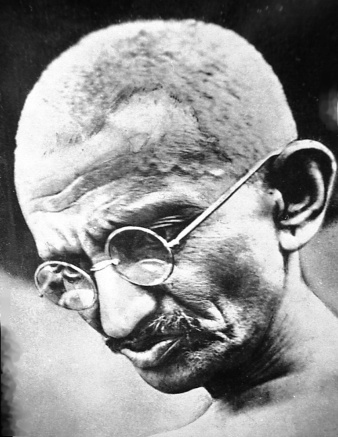
Mahatma Gandhi portrait, 1931. Image Source: Wikimedia
In much of what I’ve recently read on Gandhi, there exists the impulse to find a unifying structure which underlies his thought. Most recently I’ve been reading Faisal Devji’s The Impossible Indian, and various essays by Akeel Bilgrami on Gandhi, which exhibit this trend.[1]
I think this recent impulse might be a reaction against an older mode of thought, which is now perceived as either outmoded, or unsophisticated. In the old paradigm, Gandhi was framed either as a shrewd politician, or an irrational mystic. Both these stereotypes lend themselves to portraying a disunified view of Gandhi’s thought in which either he is inconsistent for political or philosophical reasons.
The problem for me is that the old way of thinking about Gandhi, passé and rigid though they may be, contain much which is valuable. Given his triple identity as a political philosopher-politican-mystic, I’m not sure that we, even under charitable conditions, should expect a consistent system out of Gandhi.
Gandhi was a philosopher-politician: This is perhaps the most obvious fact about Gandhi. But as of late, he seems to be treated differently from other philosopher-politicians. Consider the following names: John Stuart Mill, Woodrow Wilson, the American Founding Father, Mao Zedong, Vladimir Lenin. It is completely normal for academics to acknowledge that these people had contradictions between their political theories, and their stated/enacted policies. Rather than doing intellectual gymnastics to explain how Gandhi can simultaneously support and decry fighting in World War 2, fighting in Kashmir, and a hypothetical Indian civil war, can we not just acknowledge that Gandhi often wrote with an eye towards political strategy?